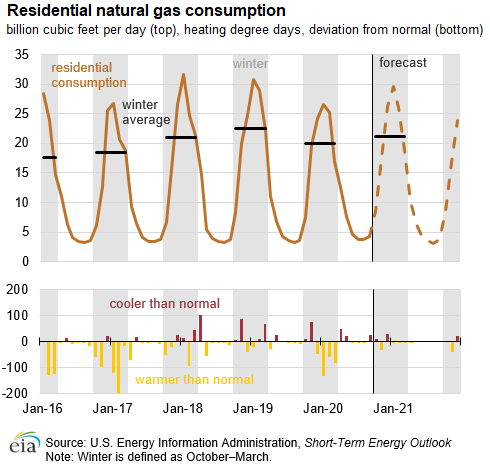EIA forecasts higher-than-average residential natural gas consumption this winter
According to October’s Short-Term Energy Outlook, EIA forecasts residential natural gas consumption for the 2020–21 winter season (October–March) to average 21.1 Bcf/d, an increase of 1.1 Bcf/d (5.3%) from the 2019–20 winter average. The higher expected residential consumption of natural gas this winter is primarily related to forecasts for colder temperatures this winter than last winter.

Last winter was notably warm, averaging 572 heating degree days (HDDs), compared with the 10-year average of 603 HDDs. The warmer-than-normal winter temperatures contributed to residential natural gas consumption averaging 20.0 Bcf/d last winter, the lowest since the 2016–17 winter. Based on weather forecasts from the National Oceanic and Atmospheric Administration (NOAA), EIA expects the 2020–21 winter to have 602 HDDs, which is only slightly higher than the 10-year average and about 5% higher than last winter. NOAA forecasts cooler-than-normal temperatures this winter in the North and warmer-than-normal temperatures in the South, which is, in part, due to the La Niña weather pattern.
Changes in consumer behavior due to COVID-19 mitigation efforts will also contribute to higher residential consumption of natural gas this winter. EIA expects work-from-home and virtual schooling policies to affect winter residential consumption because with more people home during the day, residential space heating demand will increase compared with last winter, prior to the COVID-19 pandemic.
Nearly half of all homes are primarily heated with natural gas. According to EIA’s Winter Fuels Outlook released on October 6, the average price of residential natural gas this winter for homes that primarily use natural gas for heating is expected to average $9.55 per thousand cubic feet (Mcf), down from $9.73/Mcf last winter. The lower average residential price of natural gas reflects generally lower natural gas spot prices in 2020. However, changes in natural gas spot prices generally pass through to residential consumers with considerable lag because some state utility commissions set the rates that utilities can charge for natural gas deliveries a year or more in advance. In addition, residential natural gas prices include charges not linked directly to spot natural gas prices, such as customer and distribution charges, which help utilities cover operational costs.
Despite lower prices, EIA forecasts higher residential natural gas consumption will lead to an increase in household expenditures for homes that primarily heat with natural gas. EIA forecasts average household expenditures for these homes will rise to $572 this winter, an increase of $32 (5.9%) compared with last winter.

- ExxonMobil halts 1-Bft3d blue hydrogen project in Texas
- Aramco and Yokogawa commission multiple autonomous control AI agents at Fadhili gas plant
- Ukraine will resume gas imports via Transbalkan route in November
- Mitsubishi to inject $260 MM into Brunei LNG project
- Freeport LNG (U.S.) on track to take in more natgas on Thursday after unit outage



Comments